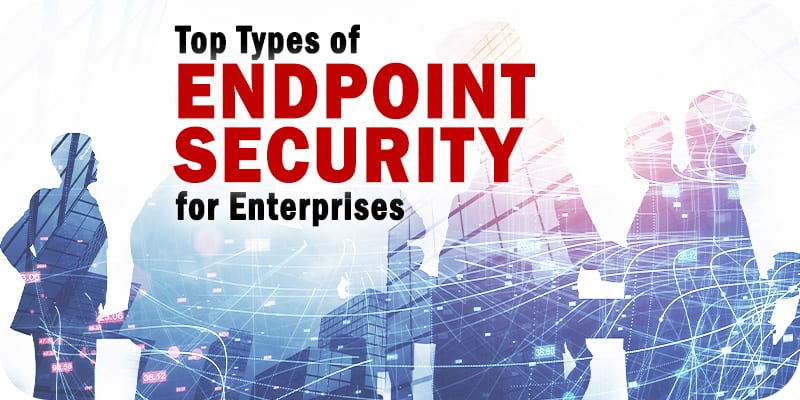The Top 11 Types of Endpoint Security for Enterprises


What are the eleven types of endpoint security? What components or tools make up comprehensive endpoint protection platforms? Which types of endpoint security should you prioritize as you seek out a next-gen cybersecurity solution?
Upon closer inspection, endpoint security proves much more diverse than it initially appears. Far from just protecting your digital perimeter, these solutions protect huge swathes of your IT environment. In fact, you consider the components of the solutions as types of endpoint security; these components can serve as individual solutions for your enterprise.
However, endpoint protection platforms serve as a way to enjoy the benefits of these types of endpoint security. Usually, this better suits your enterprise in the modern cybersecurity era—missing a crucial component could spell doom for your business. Here are the 11 types you need to know:
The 11 Types of Endpoint Security
1. Internet of Things (IoT) Security
IoT devices are becoming more ubiquitous in enterprise infrastructures as they help facilitate communications and business processes. Unfortunately, IoT devices generally inherent endpoint security. Manufacturers don’t prioritize IoT security in their products or place poor protections on those devices.
To combat this issue, providers offer IoT security as one of the types of endpoint security for enterprises. In fact, these solutions work to improve visibility in IoT devices, provide a consistent and easily upgradable layer of cybersecurity, and close security vulnerabilities into the network.
2. Antivirus Solutions
Perhaps one of the most popular and well-recognized types of endpoint security, antivirus solutions still provide critical capabilities. These include anti-malware capabilities. As such, enterprises can protect themselves against signature-based attacks, which still arise on occasion. Additionally, antivirus solutions can scan files for malicious threats via consulting against threat intelligence databases. Enterprises can install antivirus solutions directly onto their endpoints to identify unknown signatures.
However, antivirus solutions often prove limited in defending against more advanced cyber threats. Moreover, enterprises often rely too much on antivirus alone for their digital perimeter. Of the types of endpoint security, this one certainly needs the support of others.
3. Endpoint Detection and Response
A darling among the other endpoint security tools, EDR offers a capability that fits with the detection-mitigation model of modern cybersecurity. Indeed, EDR solutions continuously monitor all files and applications entering your enterprise’s endpoints. Additionally, EDR solutions can offer granular visibility, threat investigations, and detection of fileless malware and ransomware. Also, EDR provides your investigation teams with alerts for easy potential threat identification and remediation.
4. URL Filtering
URL filtering works to restricts web traffic to trusted websites; in turn, this prevents users from accessing malicious websites or websites with potentially harmful content. As an added bonus, URL filtering can prevent surreptitious downloads on your network, granting you more control over what gets downloaded where and by whom.
5. Application Control
Unsurprisingly, application control does exactly what it says on the tin; it controls applications’ permissions, ensuring strict restrictions on what they can or cannot do. To accomplish this, it uses whitelisting, blacklisting, and gray-listing to prevent malicious applications from running and compromised applications from running in dangerous ways. As enterprises continue to embrace the cloud and the potential of third-party applications in their business processes, this proves incredibly important.
6. Network Access Control
Surprisingly, network access control overlaps with identity and access management. After all, its primary focus is on securing access to network nodes. As a result, network access control determines what devices and users can access and do what on your network infrastructure. Among the types of endpoint security listed here, this one emphasizes the importance of firewalls and data limitations the most.
7. Browser Isolation
The threat facing web browsers can prove overwhelming to comprehend on a first look: surprise downloads, zero-day attacks, ransomware, cryptojacking malware, and malicious browser-executable code. Moreover, these merely skim the surface of potential cyber attacks. Browser isolation works to execute browsing sessions in isolated environments where it cannot reach valuable digital assets. Therefore, activity remains restricted to isolated environments and safe interactive media streams. Additionally, the tool destroys web browser codes after the user finishes browsing.
8. Cloud Perimeter Security
Endpoint security can no longer merely concern itself with your users’ devices. In addition, it must form a protective perimeter around your cloud environments and databases. Cloud providers are not responsible for your enterprise’s cybersecurity; hackers can target your cloud-stored assets with impunity unless you intervene.
Cloud perimeter security allows your enterprise to harden its cloud infrastructure against incoming threats.
9. Endpoint Encryption
Among the types of endpoint security, encryption often suffers from the most neglect. Yet its capabilities contribute meaningfully to any business’s digital perimeter. It prevents issues such as data leaks (whether intentional or not) via data transfer by fully encrypting that data. Specifically, it encrypts data stored on endpoints.
10. Secure Email Gateways
Email constitutes the main means of data traffic entering and exiting your digital network. Thusly, hackers exploit emails to conceal and transmit their attacks through emails more than any other attack vector. In fact, they could use email as their malware-delivery system as much as 90% of the time if not more.
Secure email gateways monitor incoming and outgoing messages for suspicious behavior, preventing them from being delivered. They can be deployed according to your IT infrastructure to prevent phishing attacks.
11. Sandboxing
A “sandbox” serves as an isolated and secure digital environment that perfectly replicates your typical end-user operating system. As such, it can contain potential threats for observation. Your IT security team can then determine their intentions before allowing them into the network. This tool can help contain zero-day threats and works well against zero-day attacks.
What Else Does Your Enterprise Need for Its Endpoint Security?
Even when these types of endpoint security become unified in an endpoint protection platform, it may not prove enough. Indeed, your enterprise also needs the benefits of centralized management, user security awareness, and mobile threat management to remain secure.
Above all, your enterprise needs several types of endpoint security if you aim to protect your users and assets. Modern threats won’t wait for you to catch up. You need an endpoint protection platform, which you can learn more about in our Endpoint Security Buyer’s Guide.




















